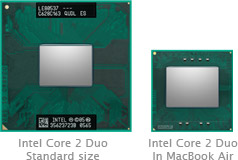 Here’s some more information about the made-for-Apple Intel Core 2 Duo chip that’s found in the new MacBook Air.
Here’s some more information about the made-for-Apple Intel Core 2 Duo chip that’s found in the new MacBook Air.
Anand Lal Shimpi over at AnandTech dug into the available data and found that the chipset is actually based on the Penryn Montevina SFF Centrino platform that’s due out later this year but with a different voltage.
It seems Apple convinced Intel to release the technology a little bit early. However, the actual Montevina package due later this year will be an ultra low voltage (ULV) processor. The one inside the Air is not. It’s lower voltage than the Intel Core 2 Duo processors found in today’s notebooks but not quite as low as it will be later this year when the actual chip is released. Basically, by shrinking the chip down now, the voltage had to be cranked up a bit.
“The shiny die connects to hundreds of pins on the bottom of the package. The more pins that need to be connected, the higher the FSB frequency and the smaller the chip the more strain this puts on the packaging technology itself. It’s quite possible that one side effect of the small form factor CPU package is worse power delivery, requiring that the chip be given a higher than normal operating voltage.”
So what will this mean for those who buy the MacBook Air? It might run a little hot unless you opt for the solid-state drive option.
“The MacBook Pro runs very hot and while the 20W TDP of the MacBook Air is significantly lower than the 35W TDP of the Pro, it’s high for such a small chassis. We won’t know for sure how hot the Air will get until it’s in our hands but the SSD route seems like an even better bet now that we know a little more about what we’re dealing with. Cutting down heat in that thin chassis will be very important, and moving to solid state storage is the only real option you have there.”
I’ll be interested to see how hot the Air runs, especially since the base-level MacBook tends to moistify the crotchal region of one’s pants after a period of extended use — at least mine did (or maybe I have an entirely different problem that I should see a doctor about). I would guess that things might not be as bad as AnandTech thinks and that Apple’s already figured out a way to disperse the heat with the Air. We’ll see, though. With a casing that skinny, the heat’s gotta go somewhere.
The MacBook Air CPU Mystery: More Details Revealed [AnandTech] via AppleInsider